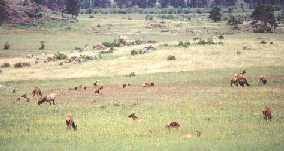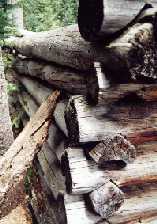Well, we had an exciting first day at the park. We had
only gotten a few yards past the campground when we spotted a bull elk with a huge rack of
horns grazing by the roadside. By the time we got the camcorder out he was wandering off
through the woods. We did get a little footage of him though. Next, we went into Rocky
Mountain National Park after purchasing a Golden Eagle pass. It's a good deal. This gives
one unlimited access for one year to any National Park. If you plan to do a lot of
traveling like us, it saves a lot on entrance fees. Another tip, visit the park during the
week to avoid some of the traffic.
 |
Once in the park, we went to Sheep Lake
where we were lucky enough to see about 5 big horn sheep wandering through. I caught a
glimpse of them up on the peak, and photographed them with my zoom lens. The ranger said
this was the first time they had seen any in a week. They are harder to find than either
elk or deer in the park. |
Next we drove west up a very steep crooked road called Old
Fall River Road (built by prison labor in the 1920's) to the top of a mountain,
with hairpin curves where you meet yourself coming back. The drop off to one side of the
road was thousands of feet with no barrier. Needless to say we hugged the other side.
| We saw several nice waterfalls on the way up and lots of
playful chipmunks, magpies, and stellar jays. We drove along the winding road through
groves of aspens at the lower altitudes. |
 |
|
 |
We went so high that we were higher than the snow and ice
patches. At the top there were no trees and the temperature was in the 40’s. At the
top we saw about 5 more elk grazing. We traveled down the other side a ways and saw
several more groups of elk and several deer. We came back up and started down the other
side back towards town. We got up above 12,000 feet at the highest point beyond the Alpine
Visitor Center. Within this area is what is referred to as alpine tundra or
"land of no trees" in Russian. High winds and long winters make this area the
way that it is. Not far from the top we saw 3 different herds of elk on the large open
meadows. There were around 15 or 20 elk in each herd. Over 400 kinds of wildlife inhabit
the park. |
| We got very close to the ice and snow but never actually
got to touch it. We came back down on a nice paved highway that wasn’t nearly as
exciting as the crooked dirt road that took us up there. It started raining on the way
down and rained more when we got back to the campground. I believe it has rained every
afternoon since we got to Colorado. |
 |
 |
At our campsite at the Blue Arrow RV Campground, we can
see mountains all the way around us. We are only about a mile from the National Park
entrance.The lounge building at the campground once was a Central City (now a ghost town)
brothel, and contains an ornate staircase taken from the former Windsor Hotel (built in
1879) in Denver. For the evening, we went to explore Estes Park; a
quaint town located right next to the park. Besides the downtown shopping area, it has an
Aerial Tram to Prospect Mountain, and an historical museum. |
| At the campground the lodge (which dates 1921) contains
interesting photos, memorabilia, and part of the bar of the old Windsor Hotel. The bar was
run by Harry Tammen, who later co-founded the Denver Post newspaper. At one time, the bar
was studded with over 3,000 silver dollars. When Calamity Jane was refused service due to
her being a woman, she reportedly shot up the bar. Prior to the campground being here,
most of the authentic old buildings were situated here in the late 1960s, for Rimrock, a
western "town" which briefly served for filming movie and TV westerns and also
had a fort and museum. Scenes from Bonanza were filmed here, and numerous western stars
appeared. The movie, "The Sinister Gold Pick," was filmed here. The land was
purchased in 1969, and then became a campground. After Indian artifacts were found in a
local cave, including blue arrowheads, the campground was renamed the Blue Arrow RV
Campground from Red Arrow. The staff is most friendly and is one of the best campgrounds
that we have stayed at. Jake, the campground mascot, is an Australian sheep dog and quite
friendly also. If you decide to visit the area and stay, be sure to mention that you read
about the area at Southpoint! |
 |
On our trek back into the park the next day, we took a
different route to the southwest leading to Bear Lake.
We stopped at the Moraine Park Museum, overlooking the Moraine Park area
(a former resort town, now reclaimed by the national park). Many wildlife and historic
books to select from here, with a museum upstairs explaining how the Rocky Mountains were
formed. We couldn’t resist buying two wildlife books to add to our collection. From
here, we stopped along the road at a picnic area to eat, and to let Gus frolic in the
creek. In looking around for photo opportunities, I came across some elk bones, all shiny
white from a coyote cleaning with fur lying around. The elk had most likely died from
natural causes, according to a local old timer, who had been fishing and happened to be
walking by.
 |
On down the road, we stopped at Sprague Lake
to view the lake and the scenic mountain background. Chipmunks provided much entertainment
as we walked, with their scurrying about. We noted a fly fisherman in waders way out in
the water. After we walked around the lake, we heard a woman screaming for help. Her
father, the fisherman, was drowning! After much excitement, we found out a little later
that he was okay. Didn't hear if he had caught anything or if something had caught him. |
On up the road, we visited Bear Lake (elevation 9,400 feet)
briefly, and decided to head back due to an impending afternoon thunderstorm. Another tip,
in the summer visit the park early in the morning, to avoid thunderstorms. While visiting
the park, we heard about two rock climbers who had died trying to climb Longs Peak, the
highest peak in the park (elevation 14,255 feet). In fact, six people have died in the
park this summer, two more from rock climbing, and another two from lightning strikes.
| On the way out of the park, we saw a very large herd of
elk (75 to 100) grazing in the field. |
 |
 |
To top the day off, we saw a DOUBLE rainbow all the way
across the sky when we got back to the campground. |
The next morning, our diesel truck decided that it was not
going to crank. After about 45 minutes of trying, we finally got it cranked, and headed
straight for the nearby Ford dealership. Found out the next day, that it was a bad starter
and glow plug relay. We had planned to stay in the area at least through Sunday anyway
since we were enjoying the scenery and wildlife so much. We got our mountain bikes out and
rode into town. The shops in the town of Estes Park
are interesting. One nature shop has fossils of all shapes that you can buy, including a
huge triceratops, which was found in South Dakota. After checking our Internet email at
the library (what a difference a T1 connection makes over a dial up!) and grabbing a bite,
we headed to the grocery and then back to the campground. Next morning we found large Elk
prints in the dust around our campsite at the far edge of the campground. Also spotted a
pile of Elk Duds (they look similar to Milk Duds).
| After picking up the truck, we headed back to the Bear
Lake area in the park to hike up to Alberta Falls. Near the area, we had
a doe cross the road right in front of us. The hike is one mile to the falls, with Aspen
and pine trees providing shade, and large boulders all around. |
 |
The falls were powerful, with large volumes of water
constantly flowing down. Wild raspberries were growing under rocks near the edge of a
cliff by the waterfall. |
| We went back to Rocky Mountain National Park today and
went on a long hike. We hiked 7.5 miles along the Colorado River to Lulu City.
There sure wasn't much left of Lulu City though. It was an old silver mine town. All we
saw was a few tumble down logs that used to be a house. We wandered off the trail and
found the old mine which had iron bars across it. We had a good time playing with a
golden-mantled ground squirrel (looks just like a chipmunk except bigger and with spots on
his stomach). I was sitting down eating peanuts and raisins and the squirrel came right up
and got on my shoe and took a peanut. While hiking back we came upon a cow elk grazing
beside the river. We watched her for a while and got some videotape. When we got close to
the parking lot there was a deer walking across near our truck. She went over to some
picnic tables and licked the barbecue grills. We got footage of that also. On the way back
over the park we saw 2 big horn sheep rams at the very top, where I videotaped them though
there was nowhere to pull over to get a real good shot. |
 |
 |
Then a few miles later we saw 2 big bull elks grazing on
the side of a mountain. We got out and got some excellent videotape footage and some
photos with the telephoto lens. One of the elk was a FOURTEEN point. The rack was huge, I
don't know how he held his head up. After that, it started raining and we came on back to
the campground. When we got to our campsite, we could hear coyotes howling in the
distance. You could also look up in the night sky and see the cloudy sketch of the Milky
Way galaxy. |
|












